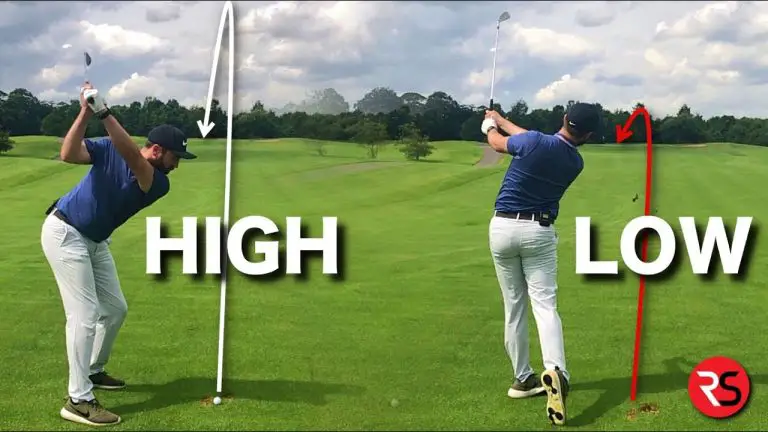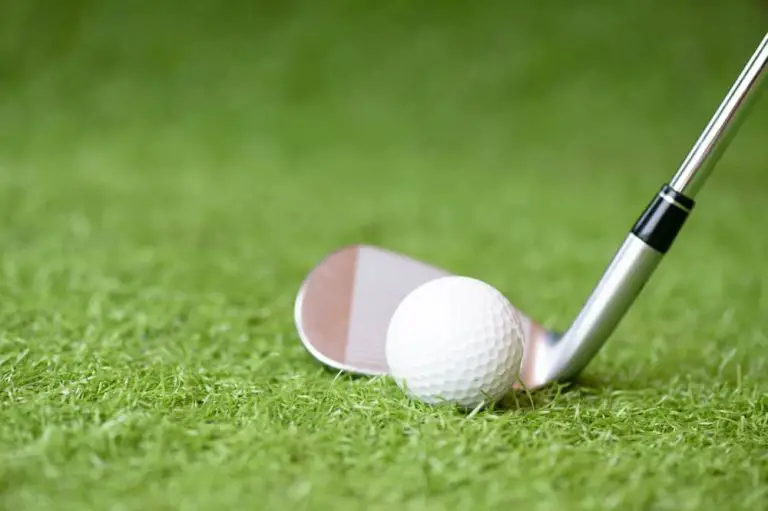What is a Strong Grip in Golf

In the realm of golf, mastering the fundamentals is essential for achieving success on the course. Among these fundamental elements is the grip – the crucial connection point between the golfer and the club. While a proper grip is important, there is a specific type of grip that has garnered significant attention and acclaim among golfers: the strong grip.
A strong grip in golf refers to a particular hand position on the club handle that can have a profound impact on a golfer’s swing and overall performance. It involves positioning the hands in a more rotated manner, resulting in a closed clubface relative to the target. This grip style is known for its ability to enhance control, power, and accuracy, making it a sought-after technique for golfers looking to elevate their game.
But what exactly constitutes a strong grip, and how does it affect the golf swing? In this article, we will explore the intricacies of a strong grip in golf, examining the positioning of the hands and fingers, its influence on swing mechanics, and the pros and cons of adopting this grip style. Furthermore, we will delve into practical tips and techniques for achieving and optimizing a strong grip, empowering you to enhance your performance and take your golf game to new heights.

What is a grip in golf?
Before diving into the concept of a strong grip, let’s start with the basics. In golf, the grip refers to how a golfer holds the club in their hands. It is the connection point between the golfer and the club, influencing the control and feel of each shot. The grip is crucial for maintaining proper swing mechanics, generating power, and delivering the clubface square to the target.
There are various types of golf grips commonly used by golfers, including the overlapping (Vardon) grip, interlocking grip, and the ten-finger grip. Each grip style has its own merits and is chosen based on personal preference, comfort, and desired shot outcome.
What is a strong grip?
A strong grip, as the name suggests, refers to a grip that places the hands in a more rotated position on the club handle. It typically involves positioning the hands more to the right (for right-handed golfers) on the grip, which results in the V formed by the thumb and index finger pointing towards the right shoulder.
The primary characteristic of a strong grip is that it promotes a closed clubface relative to the target at the address position. This means that the clubface is more turned towards the golfer’s lead side (left for right-handed golfers) rather than being square or open. The positioning of the hands in a strong grip has a direct impact on swing mechanics and shot outcomes.
The positioning of the hands and fingers
To achieve a strong grip, it is important to understand how the hands and fingers are placed on the club handle. Let’s explore the hand placement for right-handed golfers (reverse for left-handed golfers):
- Placement of the left hand: The left hand is crucial for establishing a strong grip. The “V” formed by the thumb and index finger should point towards the right shoulder. The lifeline of the left hand (the area between the thumb and index finger) should rest comfortably on the top of the grip.
- Placement of the right hand: The right hand complements the left hand in a strong grip. It should be positioned to match the left hand grip, ensuring a solid connection. The most common methods for the right hand placement are interlocking the pinky finger with the index finger of the left hand or overlapping the pinky finger onto the index and middle fingers of the left hand. The ten-finger grip, where all ten fingers are in contact with the grip, is also an option.
The influence of a strong grip on swing mechanics
A strong grip has a significant impact on swing mechanics, clubface control, and shot direction. Understanding its influence can help golfers harness the benefits of a strong grip effectively.
- Clubface control and shot direction: A strong grip promotes a closed clubface at the address, which can help counteract a slice or produce a controlled draw. By having the clubface more turned towards the golfer’s lead side, it reduces the tendency for the clubface to open prematurely during the swing. This positioning encourages a more consistent square-to-square swing path, leading to straighter shots or controlled fades and draws.
- Power generation and distance: A strong grip can contribute to increased power generation in the golf swing. When the hands are positioned more to the right, it encourages a stronger wrist hinge and promotes the ability to fully release the club through impact. This can result in a more powerful transfer of energy from the body to the club, translating into greater distance potential.
How to achieve a strong grip
Now that we understand the fundamentals of a strong grip, let’s delve into the techniques and considerations for achieving and optimizing this grip style.
Hand placement and alignment
Proper hand placement and alignment are essential for establishing a strong grip. Pay attention to the following key points:
- Correct position of the left hand: When gripping the club, ensure that the “V” formed by the thumb and index finger of your left hand points towards your right shoulder (for right-handed golfers). This positioning sets the foundation for a strong grip. Additionally, the lifeline of your left hand should rest comfortably on top of the grip, providing stability and control.
- Proper placement of the right hand: The right hand should complement the left hand grip. If using the interlocking grip, interlock the pinky finger of your right hand with the index finger of your left hand. If using the overlapping grip, position the pinky finger of your right hand on top of the index and middle fingers of your left hand. Alternatively, the ten-finger grip involves having all ten fingers in contact with the grip. Experiment with different options to find the one that feels most comfortable and secure for you.
Grip pressure and tension
In addition to hand placement, grip pressure and tension play a vital role in maintaining a strong grip. Consider the following guidelines:
- Finding the right balance of pressure: Grip the club with a firm yet relaxed grip. Avoid gripping the club too tightly, as excessive tension can impede the natural fluidity of your swing. Conversely, gripping the club too loosely may result in a loss of control. Strive for a balanced grip pressure that allows for a controlled, yet free-flowing swing.
- Avoiding excessive tension and grip pressure: Many golfers tend to unconsciously increase grip pressure during the swing, particularly during moments of tension or pressure. Be mindful of maintaining a consistent grip pressure throughout your swing, avoiding unnecessary tension in your hands and forearms. This will promote a smoother, more natural swing motion.
Practice drills and exercises to strengthen the grip
To develop a strong grip, incorporate specific drills and exercises into your practice routine. These will not only strengthen your grip but also improve overall hand and forearm strength and control. Consider the following drills:
- Grip strength training: Utilize grip strength training tools such as hand grip strengtheners, stress balls, or grip rings. Regularly performing exercises with these tools can help build hand and forearm strength, contributing to a more solid grip.
- Utilizing grip aids and training tools: Various grip aids and training tools are available to help you achieve and reinforce a strong grip. These can include training grips, grip trainers, and grip alignment tools. Consult with a golf professional or instructor to determine which tools may be beneficial for your specific needs and goals.
Remember, consistency and regular practice are key to developing and maintaining a strong grip. Incorporate these drills and exercises into your training routine to strengthen your grip and optimize your overall golf performance.
Pros and cons of a strong grip
Like any golf technique, a strong grip comes with its advantages and disadvantages. Understanding the pros and cons will help you make informed decisions about adopting and refining your grip style.
Advantages of a strong grip
- Enhanced control and shot shaping capabilities: A strong grip promotes a closed clubface, which can help you better control the direction and shape of your shots. It allows for a more reliable release of the club through impact, reducing the likelihood of an open face and minimizing errant shots.
- Increased power potential: With a strong grip, you can generate more power in your swing. The positioning of the hands encourages a greater wrist hinge, facilitating a full release of the club and maximizing the transfer of energy from your body to the ball. This can lead to increased clubhead speed and greater distance off the tee.
- Improved consistency in ball striking: A strong grip helps establish a more consistent swing path, resulting in more consistent contact with the ball. By reducing the potential for the clubface to open or close excessively, you can achieve a more predictable ball flight and improved shot-to-shot consistency.
Disadvantages of a strong grip
- Reduced flexibility in shot options: One of the downsides of a strong grip is the limited versatility it offers in shot selection. The closed clubface position makes it more challenging to execute certain shots that require an open face, such as flop shots or certain bunker shots. It’s important to recognize the trade-off between shot variety and the benefits of a strong grip.
- Potential for excessive hook or slice tendencies: While a strong grip can help minimize slices, it may increase the tendency to hook the ball, especially if your swing path is too inside-out. It’s crucial to understand the relationship between your grip, swing path, and clubface position to avoid exaggerated shot shapes that can lead to inconsistent ball flight.
- Challenges in adapting to different clubs or situations: A strong grip that works well with your driver or irons may not necessarily be suitable for other clubs or specific situations on the golf course. For instance, when hitting delicate chip shots or precise putts, a strong grip may feel restrictive and affect your touch and finesse. Adapting your grip strength based on the shot at hand is essential for optimal performance.
Adjusting grip strength for different shots
While a strong grip can be advantageous, it’s essential to adjust your grip strength based on the type of shot you intend to play. Let’s explore how to fine-tune your grip for different shots:
Adjusting grip strength for full swings
When hitting full swings with irons or woods, maintaining a strong grip is generally effective for maximizing power and control. However, slight adjustments may be necessary depending on the desired shot shape. For a straight shot, maintain a firm, strong grip. To intentionally shape the ball, you can modify your grip slightly.
- For a fade: Consider slightly weakening your grip by rotating your hands a fraction more to the left (for right-handed golfers). This adjustment helps promote a gentle left-to-right shot shape.
- For a draw: Conversely, if you want to shape the ball from right to left, slightly strengthen your grip by rotating your hands a bit more to the right (for right-handed golfers). This promotes a controlled right-to-left shot shape.
Remember to experiment with grip adjustments on the practice range to develop a feel for how they influence your shot shapes.
Modifying grip for short game shots (chips, pitches, and putts)
When it comes to short game shots, such as chips, pitches, and putts, the grip dynamics differ from full swings. While a strong grip may still be effective for certain players, a more neutral or even a slightly weaker grip is often preferred to enhance touch and precision.
- Chipping and pitching: Adopting a slightly weaker grip allows for a lighter touch and increased finesse around the greens. It enables better control over the clubhead, facilitating crisp contact and improved distance control on delicate shots.
- Putting: Many golfers opt for a neutral grip or a slightly weaker grip when putting. This grip adjustment promotes a smooth, pendulum-like stroke and encourages a square clubface alignment at impact. Experiment with different grip pressures and alignments to find what feels most comfortable and effective for your putting stroke.
Remember, short game shots rely heavily on touch, feel, and precise control. Adjusting your grip strength to match the shot requirements can greatly enhance your performance around the greens.
Common mistakes and troubleshooting
While striving for a strong grip, golfers can fall into common mistakes that can hinder their performance. Let’s explore some of these mistakes and provide troubleshooting techniques to help you overcome them.
Over-gripping and its consequences
One of the most common mistakes golfers make with their grip is over-gripping the club. Over-gripping refers to holding the club too tightly, resulting in excessive tension in the hands and forearms. This can have several negative consequences:
- Impact on swing tempo and fluidity: Over-gripping can disrupt the natural tempo and rhythm of your swing. Excessive tension restricts the free-flowing motion of your arms and can lead to a jerky or rigid swing. This can affect your timing and compromise your ability to generate power and accuracy.
Troubleshooting tip: Focus on maintaining a relaxed grip pressure throughout your swing. Practice swinging with a lighter grip and consciously release any unnecessary tension in your hands and forearms. Visualization exercises and mindful practice can help develop a more fluid and relaxed swing motion.
- Addressing tension in the hands and forearms: Over-gripping can create tension in your hands and forearms, which can affect your feel and touch during delicate shots. The added tension can also result in inconsistency and a lack of control over the clubface.
Troubleshooting tip: Prioritize awareness of your grip pressure during your practice sessions and rounds. Regularly check your grip pressure, ensuring that it is firm enough for control but not excessively tight. Focus on maintaining a relaxed grip, particularly in the fingers and thumbs, to allow for better touch and feel.
Under-gripping and its impact
While over-gripping is a common mistake, under-gripping, or holding the club too lightly, can also be problematic. Under-gripping can result in a lack of control, leading to errant shots and inconsistent ball striking.
- Lack of control and consistency: With an under-grip, the club can feel loose and unstable in your hands, making it difficult to maintain control throughout your swing. This lack of control can lead to inconsistent ball striking and a loss of accuracy.
Troubleshooting tip: Ensure that you have a firm yet relaxed grip on the club. Avoid holding the club too loosely, particularly during critical moments of your swing. Find the balance between control and freedom of motion that works best for you.
- Correcting weak grip issues: Under-gripping can be the result of a weak grip, where the hands do not have enough contact or pressure on the club. This can affect your ability to generate power and may lead to a loss of distance.
Troubleshooting tip: Check the placement of your hands on the club. Ensure that the “V” formed by your thumb and index finger (for right-handed golfers) is pointing towards your right shoulder. Experiment with grip pressure to find the sweet spot that allows for control and power.
Remember, finding the optimal grip pressure and avoiding the extremes of over-gripping and under-gripping is crucial for consistent and effective performance on the golf course. Practice mindfulness and self-awareness to develop a reliable grip that suits your playing style.
In the next and final part of this article, we will recap the importance of a strong grip, provide final tips for developing and maintaining a strong grip, and emphasize the role of practice and experimentation in finding the grip that works best for you.
Conclusion
A strong grip in golf is a vital component for golfers seeking to improve their control, power, and accuracy on the course. By understanding the key elements and techniques associated with a strong grip, you can enhance your overall performance and achieve better results in your game.
Throughout this article, we explored the definition of a grip in golf and the concept of a strong grip. We discussed the positioning of the hands and fingers to achieve a strong grip and examined how it influences swing mechanics, clubface control, and shot direction. Additionally, we provided practical tips on achieving a strong grip, including hand placement, grip pressure, and practice drills.
We also discussed the pros and cons of a strong grip, highlighting its benefits in terms of control, power, and consistency, as well as the potential drawbacks such as reduced shot variety and the risk of exaggerated shot shapes. Understanding these factors will help you make informed decisions about adopting and refining your grip style.
We explored how to adjust grip strength for different shots, emphasizing the importance of modifying your grip for full swings, chipping, pitching, and putting. Adapting your grip to suit the shot requirements will enable you to optimize your performance in various situations on the golf course.
We addressed common mistakes related to grip, such as over-gripping and under-gripping, and provided troubleshooting techniques to overcome them. By maintaining a balanced grip pressure, avoiding excessive tension, and finding the right level of control, you can address these common pitfalls and improve your overall grip stability.
Remember, developing a strong grip requires practice, patience, and experimentation. Each golfer is unique, and finding the grip that works best for you may involve some trial and error. Regular practice sessions, coupled with awareness of your grip pressure and its impact on your swing, will ultimately lead to improved performance and consistency.
So, whether you’re a beginner golfer looking to establish a solid foundation or an experienced player seeking to refine your technique, investing time and effort in developing a strong grip will undoubtedly contribute to your success on the golf course.
Keep practicing, refining your grip, and exploring what works best for you. With dedication and a strong grip, you’ll be well on your way to achieving your golfing goals. Hit the fairways with confidence and enjoy the game!





